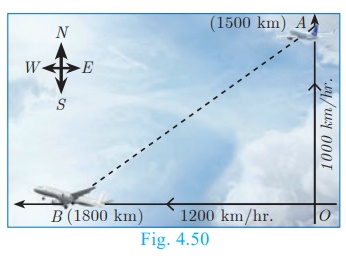Statement, Proof, Solved Example Problems | Geometry - Pythagoras Theorem | 10th Mathematics : UNIT 4 : Geometry
Chapter: 10th Mathematics : UNIT 4 : Geometry
Pythagoras Theorem
Pythagoras Theorem
Among all existing theorems in mathematics, Pythagoras theorem is
considered to be the most important because it has maximum number of proofs.
There are more than 350 ways of proving Pythagoras theorem through different
methods. Each of these proofs was discovered by eminent mathematicians,
scholars, engineers and math enthusiasts, including one by the 20th
American president James Garfield. The book titled “The Pythagorean
Proposition” written by Elisha Scott Loomis, published by the National Council
of Teaching of Mathematics (NCTM) in America contains 367 proofs of Pythagoras
Theorem.
Three numbers (a , b,c) are said to form
Pythagorean Triplet, if they form sides of a right triangle. Thus (a , b,c)
is a Pythagorean Triplet if and only if c2 = a2
+b2.
Now we are in a position to study this most famous and important theorem not only in Geometry but in whole of mathematics.
Note
·
In a right angled triangle, the side opposite to 90° (the right angle) is called the hypotenuse.
·
The other two sides are called legs of the right angled
triangle.
·
The hypotenuse will be the longest side of the triangle.
Theorem 5 : Pythagoras Theorem
Statement
In a right angle triangle, the square on the hypotenuse is equal
to the sum of the squares on the other two sides.

Proof
Given : In ΔABC, ∠A = 90°
To prove: AB 2 + AC 2 = BC 2
Construction : Draw AD ┴ BC

Adding (1) and (2) we get
AB 2+ AC 2= BC × BD + BC ×DC
= BC (BD + DC) = BC ×BC
AB 2 + AC 2= BC 2
Hence the theorem is proved.
Converse of Pythagoras Theorem
Statement
If the square of the longest side of a triangle is equal to sums
of squares of other two sides, then the triangle is a right angle triangle.
Example 4.20
An insect 8 m away initially from the foot of a lamp post which is 6 m tall, crawls towards it moving
through a distance. If its distance from the top of the lamp post is equal to
the distance it has moved, how far is the insect away from the foot of the lamp
post?
Solution
Distance between the insect and the foot of the lamp post BD
= 8 m
The height of the lamp post, AB = 6 m
After moving a distance of x m, let the insect be at C

Let, AC = CD = x . Then BC = BD
−CD = 8 − x
In
ΔABC , ∠B = 90°
AC 2 = AB2 + BC 2 gives
x 2 = 62 + (8 −
x)2
x2 = 36 + 64 − 16x + x2
16x = 100 then x = 6. 25
Then, BC = 8 − x = 8 −
6.25 = 1. 75 m
Therefore the insect is 1.75 m away from the foot of the lamp post.
Example 4.21
P and Q are the mid-points of the sides CA and CB respectively of a ΔABC, right angled at C.
Prove that 4(AQ2 + BP2 ) = 5AB2
.
Solution
Since, ΔAQC is a right triangle at C, AQ2 = AC 2+QC
2 ………(1)
Also, ΔBPC is a right triangle at C, BP2
= BC2+CP2 …….(2)

From (1) and (2), AQ2 + BP2 = AC 2
+ QC 2 + BC 2 +CP2
4(AQ2 + BP2 ) = 4AC
2 + 4QC 2 + 4BC 2
+ 4CP2
= 4AC 2 + (2QC)2 +
4BC 2 + (2CP)2
= 4AC 2 + BC 2 + 4BC 2
+ AC 2 (Since P and Q are mid points)
= 5(AC 2 + BC 2 )
4(AQ2 + BP2 ) = 5AB2 (By Pythagoras Theorem)
Example 4.22
What length of ladder is needed to reach a height of 7 ft along
the wall
when the base of the
ladder is 4 ft from the wall? Round off your answer to the next tenth place.
Solution
Let x be the length of the ladder. BC= 4 ft, AC= 7 ft.

By Pythagoras theorem we have, AB2 = AC2
+ BC2
x2 = 7 2 + 42
gives x2 = 49 + 16
x2 = 65 . Hence, x = √65
The number √65 is between 8 and 8.1.
82 = 64 < 65 < 65.61 = 8.12
Therefore, the length of the ladder is approximately 8.1 ft.
Example 4.23
An Aeroplane leaves an airport and flies due north at a speed of
1000 km/hr. At the same time, another aeroplane leaves the same airport and
flies due west at a speed of 1200 km/hr. How far apart will be the two planes
after 1½ hours?

Solution
Let the first aeroplane starts from O and goes upto A
towards north, (Distance=Speed×time)
where OA= ( 1000 × 3/2 )km =1500 km
Let the second aeroplane starts from O at the same time and
goes upto B towards west,
where OB= ( 1200 × 3/2 )km = 1800 km
The required distance to be found is BA.
In right angled tirangle AOB, AB2 =
OA2 +OB2
AB2 = (1500)2 + (1800)2 =
1002 (152+182)
= 1002 × 549 = 1002 × 9 × 61
AB = 100 × 3 × √61
= 300√(61) kms.
Related Topics